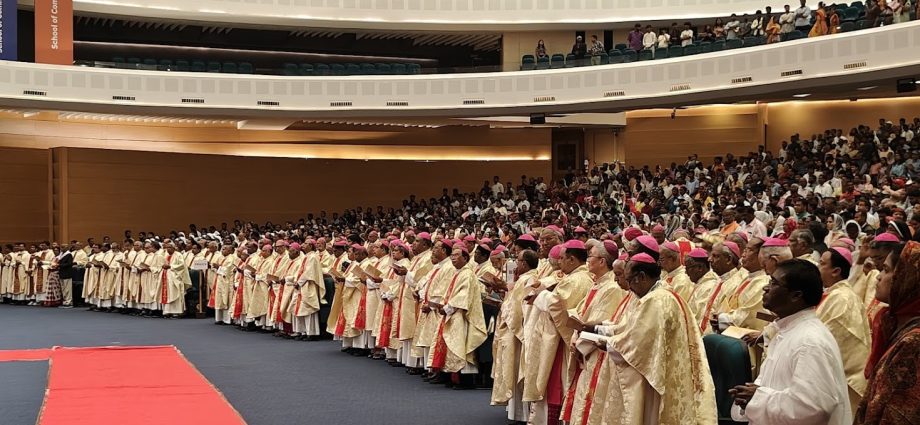By M L Satyan
Coimbatore, Feb 5, 2025: There was a cultural evening during the January 28-February 4 plenary assembly of the Latin rites bishops of India at Bhubaneswar, capital of Odisha state.
Almost all dances were performed by young girls. Important Eucharistic celebrations witnessed dances of young girls during the entrance and offertory processions. For the participants, these dances must have been spectacular. But it was an eye-soaring experience for me.
Music and dance are part of the tribal culture. Dances are performed on every auspicious occasion in the tribal communities in the north and northeastern states. I do not know when and where dance became part of the liturgical celebrations. Who introduced this culture needs to be explored.
In the similar way, dances are performed by young girls during liturgical celebrations in the southern dioceses too. Women welcome the priests with different types of Aarathi before the altar. During the nuncio’s visit to Coimbatore and Ooty dioceses in 2023, dances were performed by young girls.
In the recent past, young girls have been permitted to be ‘Altar Girls.’ Women are allowed to be in choir group and do the readings during Mass. The Archdiocese of Bombay allowed lay women and men to distribute Holy Communion after giving them due training.
As far as I know, this system is not implemented in any of the dioceses in southern India. Only nuns distribute the Holy Communion. Sadly, many parishes do not permit even nuns to distribute the Holy Communion. I have witnessed this in some parishes in the southern dioceses.
During the CCBI assembly, the nuns did the sacristy work, took part in the choir, trained young girls for dances, did clerical job, and supervised the housekeeping works. They were duly appreciated by the CCBI president during the valedictory session.
All these raise certain pertinent questions: Why do the Church authorities view young girls/women as objects of entertainment? Why are male dancers usually not included? Why are the nuns made to do menial works during such events? Why do the clergy hesitate to include women in the parish/diocesan administration? Why are women excluded from ministerial positions? Why are the commissions for women, at different levels, subservient to clericalism?
In this context, I wish to mention an incident that occurred in 2013. Bishop Eggoni Pushpalalitha of Nandyal, a diocese in Andhra Pradesh, became the first woman bishop of South Asia’s Anglican community. Her appointment as a bishop of the Church of South India had silenced critics who believed only men can play the leadership roles in the church.
Interestingly, the CSI constitution mandates that 25 percent of all statutory bodies be made up of women. In this way, CSI has been leading in revolutionary thinking from women’s education to empowerment.
At the time of episcopal ordination, Pushpalalitha said, “We are first human beings and then male or female. Some of their roles can be different, but in God’s mission there is no difference at all.”
A day before her consecration, she gave an interview to a newspaper: “Be it any institution, women are always given second-class treatment. We need to change that by promoting values that teach us not to discriminate but treat all human beings equally.”
Has the Catholic Church got to learn anything from the above example? Yes, it has to learn a lot. Why? because even after many centuries, the Catholic Church has not realized the potentials of women and the true role they need to play in the church.
Today many TV channels show women evangelists conducting prayers. Their number is growing. They pray so fervently, sing so sweetly and preach meaningfully. Their preaching is far better than many priests and bishops.
A study reveals that most women evangelists formerly belonged to the Catholic Church. If they had continued to be Catholics, they would not have become powerful and charismatic evangelists.
Today in every field, be it science, art, architecture, engineering, automobile, computer software/hardware, information technology, fashion designing, teaching, business, writing, acting, politics, religion, driving (two-wheeler, three-wheeler, four-wheeler, train, plane, ship), medical and hospitality, women have made an entry and proved to be more efficient than men.
Across all sectors and in many parts of the world, diverse women’s leadership is ascendant, and women are redefining the nature of leadership. Studies reveal that as women’s equity improves, ecological sustainability, economic development, public health, social stability and education also improve.
In this scenario, some women groups in US and other European countries have started demanding openly for women priesthood.
But in India, a vast majority of the Catholic women is in a “deep-sleep-mode.” The women associations and activists must create awareness about how the church treats them as servants. They must sensitise women to arise, awake and demand dignified positions for themselves in the church.
Conrad Hilton Foundation meeting was held at Vatican on January 22. Pope Francis met with the members of the foundation’s board of directors as well as some sisters who were taking part in a conference dedicated to religious women working in the field of communication. The important statements of the Pope are:
• Women religious are meant to be serving the poor, marginalised or vulnerable in society and not be working as servants to members of the church.
• In the past, little was invested in the formation of religious sisters, far less than in the formation of the clergy, since sisters and other women are thought to be second class citizens. That mindset must stop.
• The need for sisters to pursue continuing education and training is urgent as they are called to work among the poor.
• There are frequent complaints that there are not enough sisters in positions of responsibility in dioceses, the Roman curia and universities.
• Cultivate a vision that goes beyond the confines of your home, convent, and institution.
• We need to overcome the clerical and chauvinist mindset.
The Pope expressed his happiness about the Roman Curia having a woman prefect in the dicastery for religious as well as women in other top Vatican positions.
Considering the fast-changing trend, the Pope and the hierarchy must move beyond offering admin/clerical positions to women. The time is ripe for the Pope and the hierarchy to do a sincere introspection by shedding their ‘male-dominated conservative mindset’ and welcome women into “ministries” open-heartedly. Let us all look forward to that historical day.











